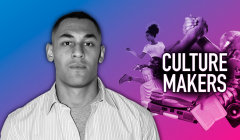
‘Subculture is the most powerful tool we have’
Louis Persent, Co-Founder and Creative Director at Weirdo on the power of embracing the niche

The&Partnership’s Andre is going back to basics to find inspiration

This article started with a neat little square, drawn in pencil, on the top left corner of my notebook, followed by the words ‘IDEAS FOR ARTICLE’. Then, for the rest of that day, every time I had a few minutes to spare in-between zoom meetings and teams’ messages, I’d force myself to look away from the screen and onto the pages below it to carry on scribbling, this time on the right hand side of the same notebook… ‘morning walks and podcasts, mid-afternoon french-press coffee making (and drinking), end-of-day cooking with the music on, Saturday morning basketball games…’
I was working from a very quiet home that day and could hear the subtle sound of the carbon lead gently scratching the surface of the paper, pulling my attention to the tools themselves. ‘ANALOG’ was the next word I wrote down, swiftly accompanied by ‘PENCIL’ and ‘NOTEBOOK’. I had my idea… ‘How analog methods helped me cope with the barrage of online connection — especially when working across time-zones — and make space for Creativity’.
I was back on the left-hand corner of the page, but this time vigorously scratching the aforementioned neat little-square.
I have always enjoyed using pencil and paper in all their different guises, mostly because I have always enjoyed what you use them for. Drawing, writing and coming up with ideas — but I hadn’t thought twice about how I used them… until lockdown hit, and all my creative life started happening in front of a screen.
It’s a well-known fact that the hand helps the head think, but what I hadn’t realised was how powerful it can be at providing focus — at its simplest, the act of looking down at the warm paper, means you’re not looking at the cold glass. So, I started there: Could I design more moments in which to give my full attention to the former, over the latter?
First things first. I already had a notebook, which I used to randomly doodle, jot down ideas or write down things-to-do with no particular system or logic. That felt like an opportunity. Looking again at the geography of the surface below I decided to, moving forward, split it in half. Inspired by the popular ‘Brain Hemisphere’ theory, on the left hand side I’d neatly write down the date, my to-do’s for the day and any important notes I’d want to retain, while keeping the right hand-side free for creative thought.
This upgrade to my analog OS gave me an end-of-week shutdown ritual and a better understanding of what’s going on in the department without the need to use my laptop or phone
Andre Moreira, Executive Creative Director, The&partnership
Forcing that separation meant I started to take extra care in how I registered the ‘important stuff’. This might not look like much but it did add an extra level of focus and time to the process which was exactly what I needed to avert my eyes from the bright white hole in front of me, even for a few additional minutes. More importantly, according to the guru of Deep Work, Cal Newport, it provided me with an end-of-day ‘shutdown ritual’: cathartically scratching off all the day’s to-do’s and attentively transcribing any incomplete ones to the subsequent page — making space for the evening to follow…
If, for any reason, I had to log-in again later on, for extra work or an after-hours zoom meeting with a remote part of the world, I’d make sure to repeat the process. The other important benefit of writing down notes is to help remove them from your head, and this is particularly relevant when working late.
This new system worked so well that I wondered if I could expand it further. Enter Sinead O’Hare, our Head of Operations. As part of her role she allocates creative talent to creative briefs and in order to keep up with what people are doing, she uses the classic whiteboard & marker combo. Writing down each creative team, the jobs they’re on and the jobs still to be allocated. It’s simple, but it works well.
So I stole adapted it for myself. Instead of a whiteboard, I chose a cork board, as I prefer the tactility of the texture. And complemented it with individual post-its for each creative or creative team, writing down in pencil, at the end of the week, what projects they’re currently working on. The great thing about post-its is the variety of shapes and sizes they come in, which allow me to easily differentiate between territories and importance of jobs (and yes, I’m an Art Director at heart, so I also enjoy the aesthetic opportunities they provide).
This upgrade to my analog OS gave me an end-of-week shutdown ritual and a better understanding of what’s going on in the department without the need to use my laptop or phone. Plus, I enjoy the process of, every Friday evening, inscribing each individual post-it by hand and pinning them onto the board. If you’re my age, you’ll remember that old file-transfer animation of a little piece of paper flying from one yellow folder to another. I truly believe an invisible file flies from my brain and onto the cork every time I pin a post-it, emptying my private cache, just in time for the weekend ahead.
‘WRITING MAKING SPACE ARTICLE’ box on the left side of the page is now scratched. Thanks all.
André oversees the creative development of all our work for Toyota, Lexus, Aon and Mars across Europe, working closely with creative leads and clients in each of the markets.
Looks like you need to create a Creativebrief account to perform this action.
Create account Sign inLooks like you need to create a Creativebrief account to perform this action.
Create account Sign in